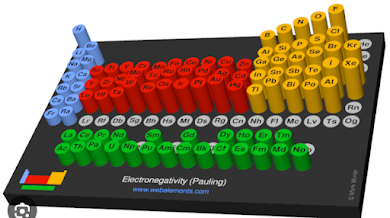Let us now give more perspective on the electronegativity explored by RealQM in the previous post as the decrease of energy achieved by hypothetically adding one electron to a given atom with kernel charge Z assuming the electron configuration of the next element in the periodic table with charge Z+1.
For example, RealQM computes a decrease of about 4 Hartree when an electron is added to Fluorine with Z=9 with electron shell configuration 2+4+3 to obtain the configuration 2+4+4 of Neon with Z=10 as the ion F-.
In a similar way we obtain energy decrease of 0.8 Hartree for Helium- (Z=2), 1.2 for Lithium- (Z=3), 1.7 for Beryllium- (Z=4) and 2.3 for Boron- (Z=5) increasing to 4 for F- (Z=9) as the maximal electronegativity for all elements.
RealQM gives the very small value 0.06 for H- in opposition to an accepted value of 2.
We next ask under what conditions the ion F- will be created from F by incorporation of one electron at an energy decrease of 4 Hartree? It directly connects to the nature of the bond of molecule HF as ionic or covalent. In an ionic bond the F atom would fully capture the electron of H with a decrease of energy of more than 3 Hartree. This is very substantial and would correspond to a dissociation energy of HF of more than 3 Hartree which is 10 times bigger than that observed.
We have earlier seen that a HF with a covalent bond has a dissociation energy in accordance with observation.
We conclude that F- appears to be hypothetical and in particular does not combine with H+ to form HF by an ionic bond. In other words, it is not clear what role electronegativity has to play if bonds are rather covalent than ionic. Any idea? Recall that direct measurement is viewed to be impossible, which gives support to a suspicion that electronegativity is more fiction than reality.
PS The accepted electronegativity of H of 2 Hartree stands out as very singular/strange:

Inga kommentarer:
Skicka en kommentar